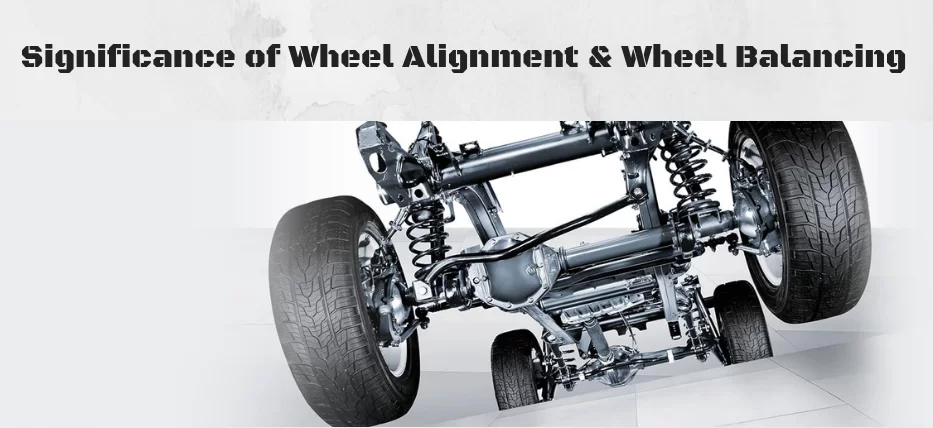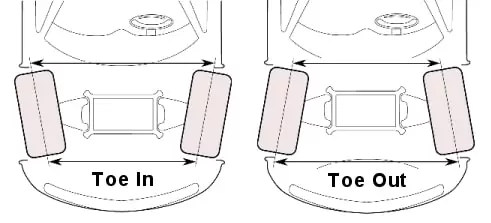When a wheel is not properly balanced, it will result in a vibration that can be experienced in the steering wheel or seat. Conversely, when a wheel is not properly aligned, it can result in severe tire wear along with steering problems. Therefore, both wheel alignment and wheel balancing are indispensable for optimal ride and handling. Let’s understand both automotive maintenance terminologies (aka Wheel Alignment & Wheel Balancing) in some detail:
1. WHEEL ALIGNMENT
The fundamental knowledge of wheel alignment states to adjust the angles of the wheels so that they remain parallel to each other and perpendicular to the ground. Well, there are many other critical situations wherein you need to check wheel alignment such as when installing new tyres or new suspensions, or when you observe strange tyre wear.
WHEN IS WHEEL ALIGNMENT NEEDED?
Wheel alignment is an essential requirement for adjusting different suspension components and measuring complex suspension angles. Actually, altering the suspensions a lot can impact the vehicle’s handling capacity and result in irregular tyre wear. Therefore, to avert extreme tyre wear, steering or tracking problems, ensure the parts affecting the alignment are inspected fittingly.
3 MAJOR COMPONENTS THAT CAN AFFECT YOUR CAR’S WHEEL ALIGNMENT
1. CAMBER
Camber, a crucial wheel’s angle, is measured in degrees and identified from the front-end view of your vehicle. Three types of camber angles exist viz. positive, negative and zero. The camber is said to be positive if you detect the top section of the wheel is leaning out of your vehicle and camber is said to be negative when your vehicle’s wheel is leaning inward. Furthermore, if you find your wheel’s camber is disordered, re-fix it immediately for averting premature tyre wear, as it can damage your vehicle’s tyre tread constantly. In reality, camber disorder can create many steering problems, as incorrect alignment can pull the tyres on to the side with the most positive camber. Nevertheless, after a detailed check on all the possibilities, if you find that the camber is not adjustable on the front-wheel-drive of your vehicle then you might require to repair or change your vehicle’s wheel.
2. CASTER
Your vehicle’s front wheels respond when the pivot connected to the suspension system is operated; caster is the angle of this steering pivot, which is viewed from the sides and measured in degrees. Similar to camber, there are two types of caster angles – positive and negative. If the top of the pivot tilts towards the rear, then the caster is positive and if it tilts towards the front of your vehicle, then it’s negative. If your vehicle’s caster gets out of its alignment, then it can harm the straight-line tracking and if it’s different on both the sides, the vehicle will pull towards the side having a negative caster. In specific cases, the caster is equal on both the sides but is too positive making the steering heavy and jerks at the smallest bump. Conversely, if the caster is too negative, it can impact the steering wheel making your vehicle off-line.
3. TOE-IN
Possibly, the simplest way to spot an incorrect wheel alignment is by a toe angle. Toe represents the angle derived from the position of the tyres from the vehicle’s top view. In fact, proper toe angle is vital for enhancing tyre’s life and curtailing tread wear. Due to unstable toe angle, many times a tyre’s tread life can be sacrificed. If the front of both the tyres begins to face each other, then it is a positive toe, whereas, if both the front tyres are facing opposite, it’s a negative toe. With the benefit of straight driving, positive toe angle has some negative impacts such as letting the wheels to produce constant force against each other and affecting your vehicle’s turning capability. Besides, a positive toe straightens out the wheels at speed and averts uneven tyre wear. In contrast, if you detect a negative toe in your vehicle then the suspension arms shall be inward, which will compensate for the crawling and level out the wheels at a particular speed. In fact, with a little change in the direction, it will cause the car to tilt towards one side and can even off-line the stability of the vehicle.
2. WHEEL BALANCING
When your car’s wheels aren’t appropriately balanced, it can wear your vehicle’s tyres early and cause quick wear to your vehicle’s shock absorbers, struts and steering components. That’s the reason it’s so vital for your vehicle to have the right wheel balance all the time, else it will affect your vehicle’s overall performance and probably increase wheel-balancing cost.
LET’S UNDERSTAND HOW WHEEL BALANCING WORKS
The weight of your car’s wheels should be identically spread to make sure wheels are appropriately balanced so that it can provide you with a smooth and comfortable ride and reduce the chances of premature tyre wear.
LOOK OUT FOR INDICATORS THAT WARN YOU
When the wheel is not properly aligned, it will give a wobbly effect when you speed up the vehicle, which can be felt in the steering wheel and the seat. Unaligned wheels can lead to excessive tyre wear, and steering or tracking problems.
TWO TYPES OF WHEEL-BALANCING SERVICE ARE AVAILABLE
1. STANDARD WHEEL BALANCING
A wheel balance makes certain that the wheel and tyre weight is equally distributed. This is done by spinning the wheel on a balancing machine that diagnoses wheel’s stability. If the wheel lacks balance, small weights are added to make sure equal weight distribution, as well as, a smooth and stable tyre rotation. The standard wheel balancing involves a cone set up to restore the wheel with the support of the balancing machine; however, it does not imitate the pressure that is applied to the wheel when it is fitted back to the vehicle using wheel nuts.
2. COMPUTERISED WHEEL BALANCING
The latest computerised wheel balancing is performed to balance your vehicle’s wheels fittingly, which will provide you with vibration-free, smooth and comfortable driving, as well as, boosts your car’s fuel economy. Haweka system is used for computerised wheel balancing and it imitates your vehicle’s wheel when it’s fixed firmly to the vehicle with the support of a plate and finger system to replicate secured wheel nuts on your car’s wheel.
THE BOTTOM LINE
Well, if your vehicle’s wheel alignment and/ or wheel balancing don’t conform to the wheel’s manufacturing norms, then it might be dangerous to drive your vehicle on public roads. If you experience/ feel any one of the above-mentioned indicators/ symptoms, then without any further delay, get the wheel alignment and/ or wheel balancing services in Sydney from the specialists – call Eagle Tyres on 02 9637 4355, and we’ll be delighted to assist you.







